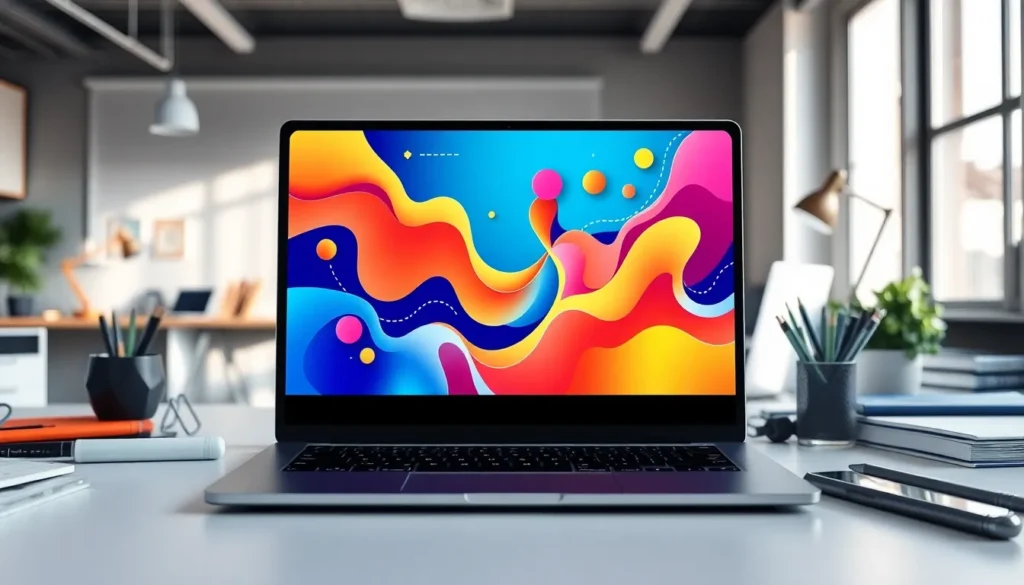In a world where attention spans are shorter than a cat video, SVG animation emerges as the superhero of web design. With its sleek scalability and lightweight charm, SVG brings graphics to life without making your website feel like it’s dragging a boulder uphill. Imagine vibrant visuals that dance across the screen, captivating users while keeping load times in check.
Table of Contents
ToggleWhat Is SVG Animation?
SVG animation refers to the use of Scalable Vector Graphics to create animation in web design. This graphic format allows for the crafting of crisp visuals that maintain their quality across different resolutions. Designers utilize SVG animation to engage users through captivating and interactive graphics that enrich the user experience.
The primary benefit of SVG animation lies in its efficiency. Lightweight by nature, SVG files often result in faster load times, which is critical for maintaining optimal website performance. Animated SVG can enhance sites without burdening bandwidth, making them ideal for mobile devices.
Developers use various techniques to animate SVG graphics. Common methods include CSS animations, SVG animation attributes, and JavaScript libraries. Each technique offers unique advantages, catering to different project requirements. Animations can be synchronized with user actions or displayed automatically, making the content more dynamic.
Moreover, SVG animations provide flexibility in design. Designers can easily modify colors, shapes, and movements without losing quality. This versatility is integral to modern web aesthetics, allowing for a seamless integration of branding elements into animations.
Given its scalability, SVG animation can adapt to any viewport size. This adaptability is crucial for responsive design, ensuring graphics look sharp on any screen, from desktop to mobile. As a result, users benefit from a consistent experience, enhancing website usability.
SVG animation stands out as an effective tool for web designers. It not only enhances visual appeal but also contributes to performance efficiency, making it a preferred choice in contemporary web design.
Benefits of SVG Animation

SVG animation offers several key advantages in web design. Its unique traits enhance both user experience and website performance.
Lightweight and Scalable
SVG files remain lightweight, meaning they load quickly and require minimal bandwidth. This efficiency benefits mobile users who rely on faster performance. Scalability represents another crucial aspect, as SVG graphics retain their quality regardless of size alterations. Designers can adjust dimensions without sacrificing clarity. Additionally, small file sizes improve load times, benefitting overall site performance. When web pages load faster, users experience higher engagement rates and lower bounce rates. Effective use of SVG animation contributes directly to better search engine optimization, ensuring websites remain competitive.
High Quality and Performance
High quality characterizes SVG animations, as they retain sharpness on any display resolution. Whether viewed on a large desktop monitor or a mobile device, SVG graphics appear crisp and clear. Performance remains a significant factor; smooth animations enhance interactivity within a site. Techniques such as CSS animations allow for seamless transitions and visually striking effects. Other attributes, like JavaScript libraries, provide even more control over animations, enabling dynamic interactions. Consistent performance leads to better user retention and satisfaction, showcasing the powerful impact of SVG animation on overall web design.
Techniques for Creating SVG Animation
SVG animation employs multiple techniques to enhance user experience. Two prominent methods include CSS animation and JavaScript animation.
CSS Animation
CSS animation simplifies the process of animating SVG elements. Designers can utilize keyframes and transitions to create smooth animations with minimal code. This technique allows for easy adjustments, such as changing colors and transforming shapes. It’s lightweight and doesn’t require additional JavaScript libraries, which improves load times and performance. Additionally, CSS animation integrates seamlessly with existing stylesheets, making it a convenient choice for many web projects. Many designers use CSS for hover effects and other interactive animations, enhancing visual engagement across a website.
JavaScript Animation
JavaScript animation offers greater control and flexibility compared to CSS. Developers can manipulate SVG elements dynamically with libraries like GreenSock or Snap.svg. This level of control enables complex animations, such as advanced movements and timeline coordination. JavaScript allows for user interaction-based triggers, fostering a more engaging experience. Additionally, asynchronous loading keeps page performance optimal while enhancing SVG interactivity. JavaScript animation is ideal for scenarios requiring intricate animation sequences or responsive design, ensuring that animations adjust smoothly across different devices.
Tools and Libraries for SVG Animation
Numerous tools and libraries facilitate the creation of SVG animations, each offering unique features that enhance usability and performance.
GreenSock Animation Platform (GSAP)
GreenSock Animation Platform, recognized as GSAP, excels in creating high-performance animations. This library supports a variety of animation techniques and provides advanced control over timing, sequencing, and performance optimizations. With its intuitive API, developers can effortlessly create complex animations while maintaining smooth performance. GSAP’s flexibility ensures compatibility with other libraries and frameworks, making it an efficient choice for intricate SVG animations. Extensive documentation and a supportive community enhance the development experience, enabling users to optimize animations for various devices and screen sizes.
Snap.svg
Snap.svg serves as another powerful library focused specifically on SVG manipulation and animation. Designed by the creators of Raphael, Snap.svg simplifies the process of working with SVG graphics through its straightforward interface. Developers can create and animate SVG elements with ease, invoking a wide array of animation features. The library supports modern web standards and allows for integration with existing SVG graphics seamlessly. Users appreciate Snap.svg for its ability to manage complex shapes and paths, ensuring precise and stunning animations. Enhanced functionalities, such as event handling and DOM manipulation, make Snap.svg an excellent choice for developing dynamic web applications.
Best Practices for SVG Animation
Optimize SVG animations for performance by minimizing the file size. Reducing the number of points in vector shapes leads to faster loading times. Keep SVG graphics clean by removing unnecessary metadata, comments, and hidden elements, which helps streamline delivery.
Use CSS for simple animations whenever possible. CSS animations provide ease of implementation and maintain a lightweight footprint. Apply keyframes and transitions effectively for smooth effects, especially during hover interactions.
Leverage JavaScript for complex animations requiring advanced controls. JavaScript enables developers to create intricate user interactions and precise timing functionality. Libraries like GreenSock and Snap.svg enhance capabilities and simplify animation creation.
Adopt responsive techniques to ensure SVG animations adapt to various screen sizes. Maintaining quality across devices is essential for user experience. Designing animations with a fluid approach guarantees that visuals remain sharp on both mobile and desktop displays.
Test animations across different browsers for compatibility issues. Certain SVG features may behave differently, impacting usability. Validating animations on multiple platforms helps ensure consistent performance and appearance.
Incorporate accessibility practices, focusing on users with disabilities. Providing alternatives or descriptions for animations ensures that everyone can engage with the content. Using role attributes and ARIA labels brings enhanced inclusivity to web design.
Maintain a clear purpose for animations in user interfaces. Animation should never distract users but rather guide them through important actions. Defining clear goals for each animation boosts overall effectiveness and contributes to improved user engagement.
Prioritize animations with a subtle approach. Overly elaborate effects may overwhelm users and slow down performance. Balancing visual appeal with practical function leads to an optimal user experience.
SVG animation stands out as a powerful asset in web design. Its lightweight nature and scalability allow for stunning visuals that engage users without sacrificing performance. By utilizing techniques like CSS and JavaScript, designers can create seamless animations that enhance interactivity and user experience.
Tools such as GSAP and Snap.svg further simplify the animation process, providing advanced control and ease of use. By following best practices for optimization and accessibility, designers can ensure that their SVG animations not only captivate but also serve a clear purpose. Embracing SVG animation can lead to a more dynamic and responsive web presence that resonates with users while boosting site performance.










